Capacity Development of Local Self-Governments for Disaster Risk Management
The objective of this research was to examine the capacity development of local self-governments in the field of disaster risk management (DRM). This quantitative research examines the degree of implementation of strategic, legislative, and institutional frameworks, as well as the capacity of local authorities to apply related policies through five analytical scopes: (1) degree of preparedness and legal framework; (2) financial framework; (3) policy aspects; (4) cooperation and partnership; (5) communication. The ability of municipalities and towns to respond to disasters was also analyzed and compared. In this paper, our initial hypothesis was that the effective implementation of the concept of DRM policy in towns of Serbia requires the continual strategic, tactical, and operational transformation of the public administration and public management system in order to strengthen the capacity of local self-governments for disaster prevention, preparation, response, and recovery. This multi-method research was conducted over the period of 2014–2017 and included the following two target groups: (a) heads of disaster sectors in local self-government units (mayor) and (b) employees of the DRM sector in local self-government units. The results of this research will enable decision makers to successfully respond to challenges and help to improve the capacity of local self-governments and public local administrations within the scope of DRM in the Republic of Serbia, based on the principles of prevention and proactive action, coordination, cooperation, partnership, and responsibility.
https://www.researchgate.net/publication/354624444_Capacity_Development_of_Local_Self-Governments_for_Disaster_Risk_Management
https://vladimircvetkovic.upravljanje-rizicima.edu.rs/naucni-radovi/
Capacity Development of Local Self-Governments for Disaster Risk Management
1. Introduction
Literature Review
- -
- Degree of preparedness and legal framework of DRM;
- -
- Financial framework of DRM;
- -
- Policy aspects (strategic and operational levels of DRM);
- -
- Cooperation and partnership (relations between the state, local authorities, and citizens within the DRM concept; formal obligations of the citizens in disaster circumstances as well as their expectations of the state; the engagement of citizens in disaster management; the role of civil society and citizen organizations; regional and international cooperation);
- -
- Communication (DRM communication, manner of providing information about disaster events, establishing communication channels, assigning liability within the concept of disaster risk communication, the monitoring and evaluation of DRM, building safety culture, the education of local self-governments in the realm of disaster risk management, providing education to citizens and encouraging their active participation, creating databases and websites that are continuously updated with disaster-related data).
2. Materials and Methods
2.1. Study Area
2.2. Basic Characteristics of Local Self-Governments
2.3. Questionnaire Design
2.4. Analyses
3. Results
- -
- Predictors of the local self-government for the capacity development of local self-governments for DRM;
- -
- Attitudes of the employees of the DRM sector in local self-government units;
- -
- Attitudes of the heads (mayor) of disaster sectors in local self-government units.
3.1. The Predictors of the Capacity Development of Local Self-Governments for Disaster Risk Management
3.2. Attitudes of the Employees of the Disaster Risk Management Sector in Local Self-Government Units
3.2.1. Degree of Preparedness and Legal Framework
3.2.2. Financial Framework for Disaster Risk Management
3.2.3. Disaster Vulnerability Assessment, Protection and Rescue Plans
3.2.4. Disaster Response Headquarters
3.2.5. Cooperation and Communication in the Context of Disaster Risk Management
3.3. Attitudes of Heads (Mayor) of Disaster Sectors in Local Self-Government Unit
- (a)
- The legal solution according to which the mayor is the commander of the disaster headquarters is good and should not be changed (X = 4.8);
- (b)
- The city administration with all sectors is fully prepared to respond to disasters (X = 4.2);
- (c)
- The competencies of local self-governments in disaster management in Serbia are fully and sufficiently precisely regulated by laws and bylaws (X = 3.8);
- (d)
- The competences that the city has in disaster management are sufficiently implemented (formed operational expert teams, appointed commissioners of civil protection and their deputies, formed and equipped and trained civil protection units, situation center, means of alert, etc.) (X = 4.1);
- (e)
- Strategic risk assessment plans provided by law are adopted and implemented in cities sufficiently and in a timely manner and the style of disaster management is mostly proactive (X = 3.8);
- (f)
- Actors in local self-government (public administration, public services and policy makers, citizens) are sufficiently trained and educated on disaster management (X = 3.6);
- (g)
- Activities and voluntary engagement of citizens in emergency situations are appropriately regulated by laws and bylaws and appropriate standard procedures (X = 3.7);
- (h)
- Civil society organizations, citizens’ associations, and volunteers are very important in disasters (X = 4.8) (Table 7). Thus, the highest values were recorded in the attitude related to the legal solution, while the lowest values were recorded in the attitude related to training and education. On the other hand, observed in relation to the city, the lowest total mean values of attitudes were recorded in the mayor from Belgrade (X = 3.3) and the highest in the mayor from Sremska Mitrovica (X = 4.5).
4. Discussion and Recommendations
5. Conclusions
Supplementary Materials
Author Contributions
Funding
Institutional Review Board Statement
Informed Consent Statement
Conflicts of Interest
Appendix A
Appendix B
References
- Afet, T.C.B.; Başkanlığı, A.D.Y. Annotated Glossary of Disaster Management Terms; Prime Ministry Disaster and Emergency Management Presidency: Ankara, Turkey, 2014.
- Ergünay, O. What is disaster management? How should it be? In the light of Erzincan and Dinar earthquakes, Turkey’s quest for solutions to earthquake problems. TUBITAK Earthq. Symp. Pap. Book 1996, 15, 263–272. [Google Scholar]
- Allahbakhshi, K.; Jahangiri, K.; Khorasani-Zavareh, D.; Choi, Y.-J.; Choi, H.-B.; O’Donnell, M. Disaster Reintegration Model: A Qualitative Analysis on Developing Korean Disaster Mental Health Support Model. Int. J. Environ. Res. Public Health 2019, 16, 2789. [Google Scholar] [CrossRef]
- Bromley, E.; Eisenman, D.P.; Magana, A.; Williams, M.; Kim, B.; McCreary, M.; Wells, K.B. How do communities use a participatory public health approach to build resilience? The Los Angeles County Community Disaster Resilience Project. Int. J. Environ. Res. Public Health 2017, 14, 1267. [Google Scholar] [CrossRef] [PubMed]
- Cvetković, V.M.; Nikolić, N.; Radovanović, N.U.; Öcal, A.; Noji, E.K.; Zečević, M. Preparedness and preventive behaviors for a pandemic disaster caused by COVID-19 in Serbia. Int. J. Environ. Res. Public Health 2020, 17, 4124. [Google Scholar] [CrossRef]
- Öcal, A.; Cvetković, V.M.; Baytiyeh, H.; Tedim, F.M.S.; Zečević, M. Public reactions to the disaster COVID-19: A comparative study in Italy, Lebanon, Portugal, and Serbia. Geomat. Nat. Hazards Risk 2020, 11, 1864–1885. [Google Scholar] [CrossRef]
- Eriksson, O.; Gustafsson, M. Disaster Management Capacity from a National Perspective; Lund University: Lund, Sweden, 2007. [Google Scholar]
- Hagelsteen, M.; Becker, P. Challenging disparities in capacity development for disaster risk reduction. Int. J. Disaster Risk Reduct. 2013, 3, 4–13. [Google Scholar] [CrossRef]
- Hagelsteen, M.; Burke, J. Practical aspects of capacity development in the context of disaster risk reduction. Int. J. Disaster Risk Reduct. 2016, 16, 43–52. [Google Scholar] [CrossRef]
- Schulz, K.; Gustafsson, I.; Illes, E. Manual for Capacity Development; Sida: Stockholm, Sweden, 2005. [Google Scholar]
- United Nations Educational, Scientific and Cultural Organization (UNESCO). Guidebook for Planning Education in Emergencies and Reconstruction; IIEP-Unesco: Paris, France, 2006; Available online: http://www.preventionweb.net/files/8401guidebook.pdf (accessed on 3 November 2014).
- McEntire, D. Understanding and reducing vulnerability: From the approach of liabilities and capabilities. Disaster Prev. Manag. 2012, 21, 206–225. [Google Scholar] [CrossRef]
- Wolensky, R.P.; Wolensky, K.C. Local Government’s Problem with Disaster Management: A Literature Review and Structural Analysis. Rev. Policy Res. 1990, 9, 703–725. [Google Scholar] [CrossRef]
- Goyal, N. Disaster governance and community resilience: The law and the role of SDMAs. Int. J. Disaster Risk Manag. 2019, 1, 61–75. [Google Scholar] [CrossRef]
- International Labor Organization. Capacity Building and Training for Disaster Risk Reduction in Recovery Management; IRP Secretariat, International Recovery Platform: New York, NY, USA, 2005; Available online: http://www.recoveryplatform.org/assets/meetings_trainings/sideevent_iatf_12/200511_ilo_dis.pdf (accessed on 3 October 2014).
- Güler, H.H. Disaster Praparedness. In Afet Yönetiminin Temel İlkeleri; Kadıoğlu, M., Özdamar, E., Eds.; T.C İçişleri Bakanlığı-Japonya Uluslararası İşbirliği Ajansı (JICA): Ankara, Turkey, 2005. [Google Scholar]
- United States Agency International Development (USAID). Organizational Capacity Building Framework: A Foundation of Stronger More Sustainable HIV/AIDS Programs, Organizations & Networks; North Fairfax Drive: Arlington, TX, USA, 2011. Available online: https://www.msh.org/sites/default/files/as2_technical_brief_2_final.pdf.pdf (accessed on 21 November 2014).
- Tadele, F.; Manyena, S.B. Building disaster resilience through capacity building in Ethiopia. Build. Disaster Resil. 2009, 18, 317–326. [Google Scholar] [CrossRef]
- Japan International Cooperation Agency (JICA). Building Disaster Resilient Societies; JICA: Tokyo, Japan, 2008. Available online: http://www.jica.go.jp/english/our_work/thematic_issues/water/pdf/cooperation_01.pdf (accessed on 1 November 2014).
- Becker, P. Grasping the hydra: The need for a holistic and systematic approach to disaster risk reduction. Jàmbá J. Disaster Risk Stud. 2009, 2, 12–24. [Google Scholar] [CrossRef]
- CADRI. Basics of Capacity Development for Disaster Risk Reduction; Capacity for Disaster Reduction Initiative: Geneva, Switzerland, 2011. [Google Scholar]
- Grejin, H.; Hauck, V.; Land, T.; Ubels, J. Capacity Development Beyond Aid; SNV Netherlands Development Organisation: Hague, The Netherlands; European Centre for Development Policy Management (ECDPM): Maastricht, The Netherlands, 2015. [Google Scholar]
- UNDP (UNISDR). Disaster Risk Reduction Rethinking Capacity Development; United Nations Development Programme: Geneva, Switzerland, 2006. [Google Scholar]
- Scott, Z.; Few, R.; Leavy, J.; Tarazona, M.; Wooster, K. Strategic Research into National and Local Capacity Building for Disaster Risk Management—Literature Review; Oxford Policy Management: Oxford, UK, 2014. [Google Scholar]
- Dragicevic, S.; Filipovic, D.; Kostadinov, S.; Ristic, R.; Novkovic, I.; Zivkovic, N.; Djurdjic, S. Natural hazard assessment for land-use planning in Serbia. Int. J. Environ. Res. 2011, 5, 371–380. [Google Scholar]
- Cvetković, V.; Dragicević, S. Spatial and temporal distribution of natural disasters. J. Geogr. Inst. Jovan Cvijic SASA 2014, 64, 293–309. [Google Scholar] [CrossRef]
- Dragićević, S.; Mészáros, M.; Djurdjić, S.; Pavić, D.; Novković, I.; Tošić, R. Vulnerability of National Parks to Natural Hazards in the Serbian Danube Region. Pol. J. Environ. Stud. 2013, 22, 1053–1060. [Google Scholar]
- Cvetković, V. Strengthening integrated disaster risk management system in Serbia: DISARIMES. Zb. Rad. Taktika Zaštite Spasavanja Vanred. Situac. Beogr. 2021, 1, 77–111. [Google Scholar]
- Official Gazette Republic of Serbia. Law on Disaster Risk Reduction and Emergency Management; No. 87; National Assembly: Belgrade, Serbia, 2018.
- Cvetković, V.M.; Roder, G.; Öcal, A.; Tarolli, P.; Dragićević, S. The role of gender in preparedness and response behaviors towards flood risk in Serbia. Int. J. Environ. Res. Public Health 2018, 15, 2761. [Google Scholar] [CrossRef] [PubMed]
- Official Gazette Republic of Serbia. Law on Elimination of the Consequences of Floods in the Republic of Serbia; No. 75; National Assembly: Belgrade, Serbia, 2014.
- Official Gazette Republic of Serbia. The National Strategy for Protection and Rescue in Emergency Situations; No. 86; National Assembly: Belgrade, Serbia, 2011.
- Rosenthal, U.; Hart, P.; Kouzmin, A. The Bureau-Politics of Crisis Management. Public Adm. 1991, 69, 211–233. [Google Scholar] [CrossRef]
- Al-Nammari, F.; Alzaghal, M. Towards local disaster risk reduction in developing countries: Challenges from Jordan. Int. J. Disaster Risk Reduct. 2015, 12, 34–41. [Google Scholar] [CrossRef]
- Sinha, A. A Holistic Framework for Capacity Building to Achieve Sustainable Water Management System in Arid and Semi-Arid Lands of Africa. Master’s Thesis, Purdue University, West Lafayette, IN, USA, 2012. [Google Scholar]
- Centre for International Studies and Cooperation. Framework on Community Based Disaster Risk Management in Vietnam. Available online: http://www.ceci.ca/assets/Asia/Asia-Publications/CBDRM-Framework.pdf (accessed on 21 November 2014).
- Boonreang, E. The Capacity Building in the Natural Disaster Management of Thailand. Int. J. Econ. Manag. Eng. 2015, 9, 1576–1581. [Google Scholar]
- Harkey, J. Experiences of National Governments in Expanding Their Role in Humanitarian Preparedness and Response; Feinstein International Center—Tufts University: Boston, MA, USA, 2014. [Google Scholar]
- Schwartz, R.; Sulitzeanu-Kenan, R. Managerial values and accountability pressures: Challenges of crisis and disaster. J. Public Adm. Res. Theory 2004, 14, 79–102. [Google Scholar] [CrossRef]
- UNISDR. Sendai Framework for Disaster Risk Reduction 2015–2030; United Nations: Geneva, Switzerland, 2015. [Google Scholar]
- Pandey, B.H.; Okazaki, K. Community-Based Disaster Management: Empowering Communities to Cope with Disaster Risks. Available online: http://www.unpan1.un.org/intradoc/groups/public/documents/un/unpan020697.pdf (accessed on 1 July 2021).
- Alcayna, T.; Bollettino, V.; Dy, P.; Vinck, P. Resilience and disaster trends in the Philippines: Opportunities for national and local capacity building. PLoS Curr. 2016, 8. [Google Scholar] [CrossRef] [PubMed]
- Uy, N.; Takeuchi, Y.; Shaw, R. Local adaptation for livelihood resilience in Albay, Philippines. Environ. Hazards 2011, 10, 139–153. [Google Scholar] [CrossRef]
- Botha, D.; Van Niekerk, D. Views from the Frontline: A critical assessment of local risk governance in South Africa. Jàmbá J. Disaster Risk Stud. 2013, 5, 1–10. [Google Scholar] [CrossRef]
- Coppola, D.P. Strategic Approach to Capacity Development for Implementation of the Sendai Framework for Disaster Risk Reduction: A Vision of Risk-Informed Sustainable Development by 2030; UNISDR: Geneva, Switzerland, 2018. [Google Scholar]
- United Nations International Strategy for Disaster Reduction (UNISDR). Hyogo Framework for Action 2005–2015; UNISDR: Geneva, Switzerland, 2005. [Google Scholar]
- Hagelsteen, M.; Becker, P. Systemic problems of capacity development for disaster risk reduction in a complex, uncertain, dynamic, and ambiguous world. Int. J. Disaster Risk Reduct. 2019, 36, 101102. [Google Scholar] [CrossRef]
- UNDP. Strengthen the Capacities of Disaster Risk Reduction. 2011. Available online: https://www.preventionweb.net/files/globalplatform/entry_bg_paper~strengtheningcapacityfordrraprimerfullreport.pdf (accessed on 11 July 2021).
- Global Facility for Disaster Reduction and Recovery (GFDRR). Reviewing the Impact of Capacity Building in GFDRR. 2016. Available online: https://reliefweb.int/sites/reliefweb.int/files/resources/CapBld-Mini-Web.pdf (accessed on 15 July 2021).
- Iizuka, A. Developing capacity for disaster risk reduction: Lessons learned from a case of Sri Lanka. Prog. Disaster Sci. 2020, 6, 100073. [Google Scholar] [CrossRef]
- Gavrilović, D. Municipalities and Regions in the Republic of Serbia; Republican Bureau of Statistics of Serbia: Belgrade, Serbia, 2019.
- Kovačević-Majkić, J.; Panić, M.; Miljanović, D.; Miletić, R. Vulnerability to natural disasters in Serbia: Spatial and temporal comparison. Nat. Hazards 2014, 72, 945–968. [Google Scholar] [CrossRef]
- Cvetković, V.M.; Öcal, A.; Ivanov, A. Young adults’ fear of disasters: A case study of residents from Turkey, Serbia and Macedonia. Int. J. Disaster Risk Reduct. 2019, 35, 101095. [Google Scholar] [CrossRef]
- Cvetković, V.M.; Kevin, R.; Shaw, R.; Filipović, M.; Mano, R.; Gačić, J.; Jakovljević, V. Household earthquake preparedness in Serbia—A study from selected municipalities. Acta Geogr. 2019, 59, 27–42. [Google Scholar]
- Marovic, M.; Djokovic, I.; Pesic, L.; Radovanovic, S.; Toljic, M.; Gerzina, N. Neotectonics and seismicity of the southern margin of the Pannonian basin in Serbia. EGU Stephan Mueller Spec. Publ. Ser. 2002, 3, 277–295. [Google Scholar] [CrossRef]
- Petrović, A.; Kostadinov, S.; Dragićević, S. The inventory and characterization of torrential flood phenomenon in Serbia. Pol. J. Environ. Stud. 2014, 23, 823–830. [Google Scholar]
- Ristić, R.; Kostadinov, S.; Radić, B.; Trivan, G.; Nikić, Z. Torrential Floods in Serbia—Man Made and Natural Hazards. In Proceedings of the 12th Congress Interpraevent 2012, Grenoble, France, 23–26 April 2012; pp. 771–779. [Google Scholar]
- Cvetković, V.; Milašinović, S.; Lazić, Ž. Examination of citizens’ attitudes towards providing support to vulnerable people and volunteering during disasters. J. Soc. Sci. TEME 2018, 42, 35–56. [Google Scholar]
- Aleksić, P.; Krstić, M.; Jančić, G. Forest fires-ecological and economic problem in Serbia. Bot. Serb. 2009, 33, 169–176. [Google Scholar]
- Kešetović, Ž. Kapaciteti lokalne samouprave u Srbiji za upravljanje u katastrofama. Časopis za Javnu Politiku Polis 2014, 8, 11–16. [Google Scholar]
- Lalonde, C. Crisis management and organizational development: Towards the conception of a learning model in crisis management. Organ. Dev. J. 2007, 25, 17–26. [Google Scholar]
- Tyebkhan, G. Declaration of Helsinki: The ethical cornerstone of human clinical research. Indian J. Dermatol. Venereol. Leprol. 2003, 69, 245–247. [Google Scholar] [PubMed]
- Shi, D.; DiStefano, C.; McDaniel, H.L.; Jiang, Z. Examining chi-square test statistics under conditions of large model size and ordinal data. Struct. Equ. Model. Multidiscip. J. 2018, 25, 924–945. [Google Scholar] [CrossRef]
- Kim, T.K. T test as a parametric statistic. Korean J. Anesthesiol. 2015, 68, 540. [Google Scholar] [CrossRef]
- Tabachnick, B.G.; Fidell, L.S.; Ullman, J.B. Using Multivariate Statistics; Pearson: Boston, MA, USA, 2007. [Google Scholar]
- OECD. The Challenge of Capacity Development: Working towards Good Practice; OECD: Paris, France, 2006. [Google Scholar]
- Eade, D. Capacity-Building: An Approach to People-Centred Development; Oxfam: Oxford, UK, 1997. [Google Scholar]
- Martin, J.Q. At Risk: Natural Hazards, People’s Vulnerability and Disasters. J. Int. Aff. 2006, 59, 369. [Google Scholar]
- Carley, K.M.; Harrald, J.R. Organizational Learning under Fire: Theory and Practice. Am. Behav. Sci. 1997, 40, 310–332. [Google Scholar] [CrossRef]
- Alexander, D. Towards the development of standards in emergency management training and education. Disaster Prev. Manag. Int. J. 2003, 12, 113–123. [Google Scholar] [CrossRef]
- Caymaz, E.; Akyon, F.V.; Erenel, F. A model proposal for efficient disaster management: The Turkish sample. Proc. Soc. Behav. Sci. 2013, 99, 609–618. [Google Scholar] [CrossRef]
- Rahman, B.A. Issues of disaster management preparedness: A case study of directive 20 of National Security Council Malaysia. Int. J. Bus. Soc. Sci. 2012, 3, 85–92. [Google Scholar]
- Chhetri, M.B.P. A Practitioner’s view of disaster management in Nepal: Organisation, system, problems and prospects. Risk Manag. 2001, 3, 63–72. [Google Scholar] [CrossRef]
- Erramilli, B.P. Disaster Management in India: Analysis of Factors Impacting Capacity Building; Georgia State University: Atlanta, GA, USA, 2009. [Google Scholar]
- Kartez, J.D.; Lindell, M.K. Planning for uncertainty: The case of local disaster planning. J. Am. Plan. Assoc. 1987, 53, 487–498. [Google Scholar] [CrossRef]
- Motes, P.S.; Hess, P.M. Collaborating with Community-Based Organizations through Consultation and Technical Assistance; Columbia University Press: New York, NY, USA, 2007. [Google Scholar]
- Fujita, K.; Shaw, R. Preparing International Joint Project: Use of Japanese flood hazard map in Bangladesh. Int. J. Disaster Risk Manag. 2019, 1, 62–80. [Google Scholar] [CrossRef]
- Guo, X.; Kapucu, N. Examining stakeholder participation in social stability risk assessment for mega projects using network analysis. Int. J. Disaster Risk Manag. 2019, 1, 1–31. [Google Scholar] [CrossRef]
- Öcal, A. Disaster management in Turkey: A spatial approach. Int. J. Disaster Risk Manag. 2021, 3, 15–22. [Google Scholar] [CrossRef]
- Kusumasari, B.; Alam, Q.; Siddiqui, K. Resource capability for local government in managing disaster. Disaster Prev. Manag. Int. J. 2010, 19, 438–451. [Google Scholar] [CrossRef]
- Olawuni, P.; Olowoporoku, O.; Daramola, O. Determinants of Residents’ Participation in Disaster Risk Management in Lagos Metropolis Nigeria. Int. J. Disaster Risk Manag. 2020, 2, 1–19. [Google Scholar] [CrossRef]
- Statistical Office of the Republic of Serbia. Municipalities and Regions in the Republic of Serbia. 2017. Available online: http://pod2.stat.gov.rs/ObjavljenePublikacije/G2016/pdf/G20162020.pdf (accessed on 4 November 2017).





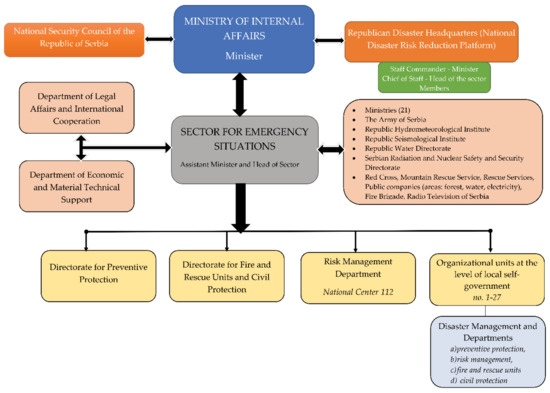
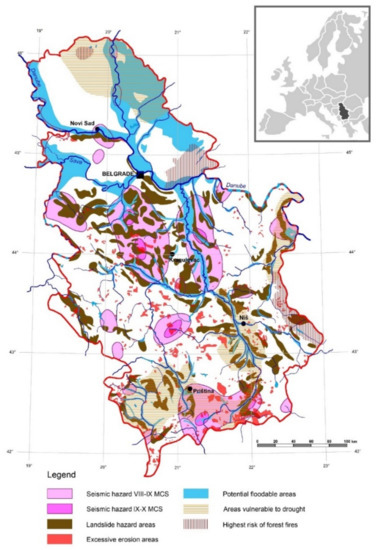
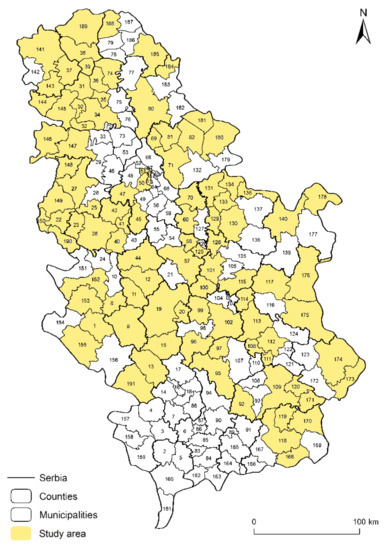

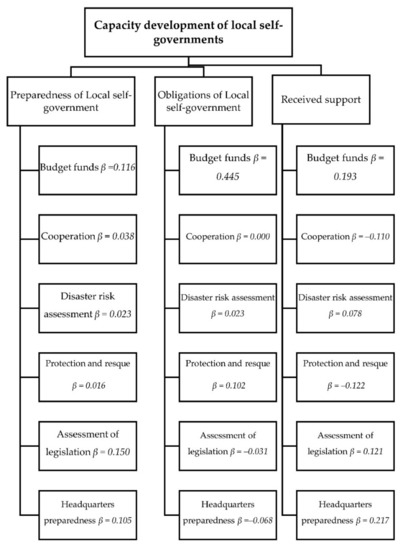
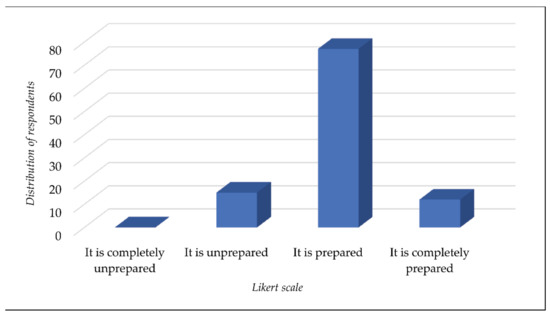
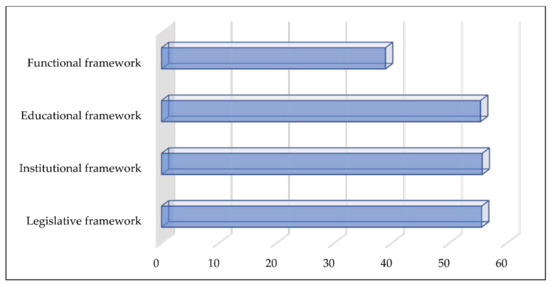
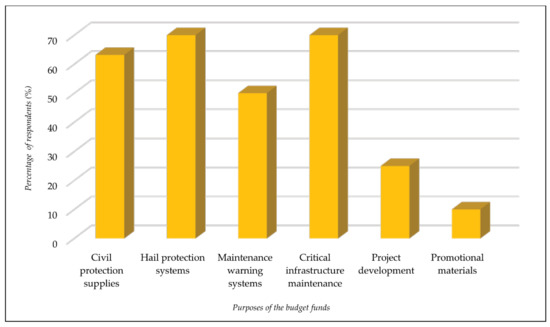
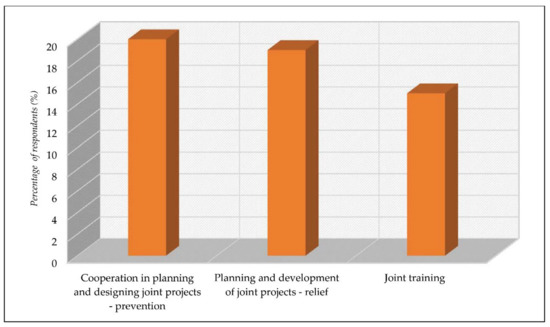
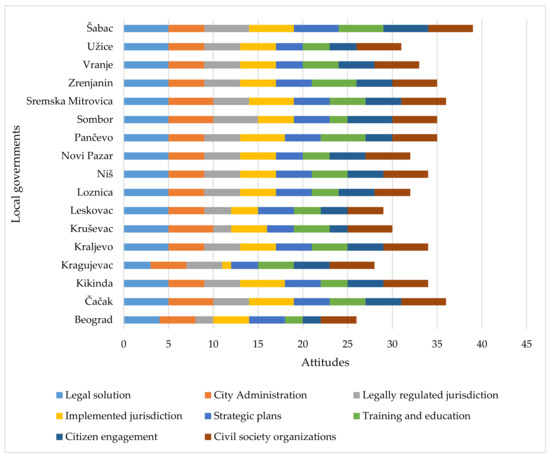

Коментари
Постави коментар